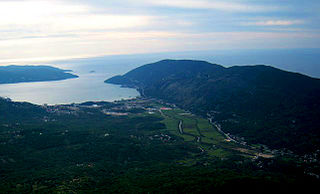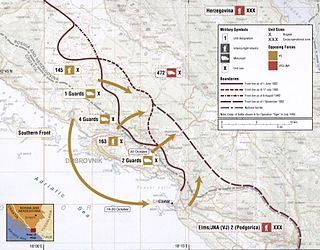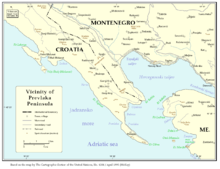
Since the breakup of the Socialist Federal Republic of Yugoslavia in the early 1990s, the foreign policy of the newly established Federal Republic of Yugoslavia was characterized primarily by a desire to secure its political and geopolitical position and the solidarity with ethnic Serbs in other former Yugoslav republics through a strong nationalist campaign. While the country was involved in Yugoslav Wars and therefore exposed to several rounds of devastating sanctions against Yugoslavia this involvement was often denied for political or ideological reasons. In the initial period Federal Republic of Yugoslavia unsuccessfully aspired to gain international recognition as the sole legal successor state to SFR Yugoslavia, the country which was one of the most prominent foreign policy subjects during the Cold War.

Prevlaka is a small peninsula in southern Croatia, near the border with Montenegro, at the entrance to the Bay of Kotor on the eastern Adriatic coast.
The Yugoslav First League was the premier football league in the Kingdom of Yugoslavia (1918–1941) and Socialist Federal Republic of Yugoslavia (1945–1992).

The Social Democratic Party of Bosnia and Herzegovina, also simply known as the Social Democratic Party is a social-democratic political party in Bosnia and Herzegovina.

Neum is a town and municipality in Bosnia and Herzegovina, located in Herzegovina-Neretva Canton of the Federation of Bosnia and Herzegovina. It is the only town on the Bosnia and Herzegovina coastline, making it the country's only access to the Adriatic Sea. As of 2013, Neum municipality has a population of 4,653 inhabitants, while the town of Neum has a population of 3,013 inhabitants.

Herceg Novi is a town in Coastal region of Montenegro located at the Western entrance to the Bay of Kotor and at the foot of Mount Orjen. It is the administrative center of the Herceg Novi Municipality with around 33,000 inhabitants. The town was founded as a fortress in 1382 by the King of Bosnia, Tvrtko I Kotromanić, and named after Saint Stephen but the name did not stick, instead it became known as Novi (transl. New), also Castelnuovo in Italian. Between 1482 and 1687 it was part of the Ottoman Empire and then from 1687 to 1797 the Albania Veneta of the Republic of Venice. It was a Catholic bishopric and remains a Latin titular see as Novi. Herceg Novi has had a turbulent past, despite being one of the youngest settlements on the Adriatic. A history of varied occupations has created a blend of diverse and picturesque architectural style in the city.

After a period of political and economic crisis in the 1980s, the constituent republics of the Socialist Federal Republic of Yugoslavia split apart, but the unresolved issues caused a series of inter-ethnic Yugoslav Wars. The wars primarily affected Bosnia and Herzegovina, neighbouring parts of Croatia and, some years later, Kosovo.

FK Igalo is a Montenegrin football club based in Igalo, Herceg Novi municipality. The club was founded in 1929 and currently competes in the Montenegrin Second League.

Sutorina is a village and a river located in Herceg Novi Municipality in southwestern Montenegro.

Bakir Izetbegović is a Bosnian politician who served as the 6th Bosniak member of the Presidency of Bosnia and Herzegovina from 2010 to 2018. He is the current president of the Party of Democratic Action (SDA).

The foreign relations between Bosnia and Herzegovina (BiH) and Croatia are bound together by shared history, language, neighboring geography and cultural commonalties. They established diplomatic relations in 1992, following the dissolution of Yugoslavia and independence of Croatia. The two countries share a 932-kilometer (579 mi) border – the second longest external land border in the European Union (EU). Modern relations between the two states are functional but remain tense after ineffective 21st-century attempts at détente.

United Nations Security Council resolution 981, adopted unanimously on 31 March 1995, after reaffirming all resolutions on the situation in the former Yugoslavia, the council established the United Nations Confidence Restoration Operation in Croatia (UNCRO) for a period terminating 30 November 1995.

United Nations Security Council resolution 1066, adopted unanimously on 15 July 1996, after recalling previous resolutions on Croatia including resolutions 779 (1992), 981 (1995), 1025 (1995) and 1038 (1996), the Council authorised military observers to continue monitoring the demilitarisation in the Prevlaka peninsula area of Croatia until 15 January 1997.

Montenegrin nationalism is the nationalism that asserts that Montenegrins are a nation and promotes the cultural unity of Montenegrins.

The Dubrovnik Republic was a Serb proto-state that existed during the Siege of Dubrovnik in the Croatian War of Independence, self-proclaimed by the Yugoslav People's Army on 15 October 1991 in occupied areas of Croatia, after being captured by members of 2nd Corps of the JNA. Its provisional president was Aleksandar Aco Apolonio.

Operation Tiger was a Croatian Army (HV) offensive conducted in areas of Croatia and Bosnia and Herzegovina near Dubrovnik between 1 and 13 July 1992. It was designed to push the Army of Republika Srpska (VRS) away from the city towards Popovo field and secure a supply route via Rijeka Dubrovačka, which was gained in early June as the siege of Dubrovnik by the Yugoslav People's Army (JNA) was lifted. The operation's success was facilitated by the establishment of the HV's Southern Front command and the successful conclusion of the May–June 1992 operations against the VRS in the Neretva River valley, which concluded with Operation Jackal.

Denis Bećirović is a Bosnian politician, professor and historian serving as the 8th and current Bosniak member of the Presidency of Bosnia and Herzegovina since 2022. He has also been serving as its chairman since March 2024. Previously, Bećirović was a member of the national House of Peoples from 2019 to 2022. He is also the current vice-president of the Social Democratic Party.

UDIK, the Association for Social Research and Communications, is the Bosnian non-governmental organization with offices in Sarajevo and Brčko. It was founded in 2013 by Edvin Kanka Ćudić. Organization aimed to gather facts, documents, and data on genocide, war crimes, and human rights violations in Bosnia and Herzegovina and the former Yugoslavia.

Šefik Džaferović is a Bosnian politician who served as the 7th Bosniak member of the Presidency of Bosnia and Herzegovina from 2018 to 2022. He has been serving as member of the national House of Peoples since 2023. A high ranking member of the Party of Democratic Action, he was formerly its vice president and general secretary.



















